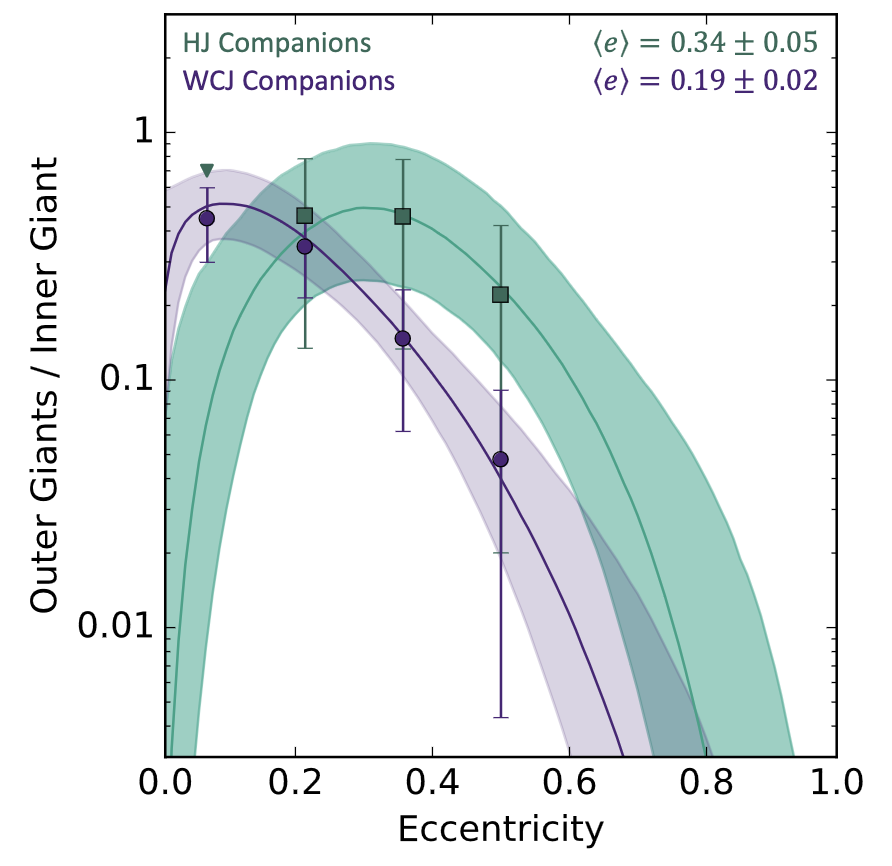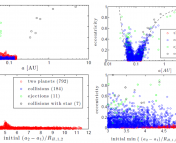Title: Hot Jupiters Have Giant Companions: Evidence for Coplanar High-Eccentricity Migration
Authors: Jon Zink, Andrew Howard
First Author’s Institution: Department of Astronomy, California Institute of Technology, Pasadena, CA 91125, USA
Status: Accepted to Astrophysical Journal Letters [open access, preprint on arXiv]
The first exoplanets found were the size of Jupiter, but orbited their host stars closer than Mercury does our Sun. Astronomers call them Hot Jupiters (HJs), but aren’t sure why they exist. In today’s bite, a new population-level analysis finds evidence that on average, solar systems with a HJ also have an outer companion three times the mass of the HJ. They also show that, on average, these outer companions have more eccentric orbits than giant planet systems without HJs. This appears to suggest most HJs form far away from their host star, and are herded inwards by coplanar outer giant companions.
Giant exoplanets and their companions
Planets form within protoplanetary disks, pancakes of gas and dust circling around young stars that are byproducts of star formation. In general, giant planets are thought to form in the outer regions of these disks, where water and carbon monoxide cool into ice crystals that can clump together, snowballing into cores many times more massive than the Earth. It was a surprise, then, for the first discovered exoplanets to have masses similar to Jupiter, but orbit their stars very close in.
Some hypotheses suggest that HJs formed exactly where they orbit today, or were pushed closer to the star by the gas in the protoplanetary disk, but these now seem unlikely. It has long been thought that these planets formed far out, waited until the protoplanetary disk disappeared, and then migrated inwards onto close in orbits.
These planetary systems could also host other exoplanets, brown dwarfs, or binary stars (in general, astronomers often refer to all of these as “companions”). The gravitational interactions between the host star, planet, and outer companion could result in the change in the planet’s orbit, since the orbit of the star and companion can exchange angular momentum with the orbit of the star and planet.
Even if we expect that these planets formed far out, their migration could be triggered by different processes. Some believe distant binary stars could push their orbits inwards, and then the planet could become trapped by the tidal forces of the star. Others believe that interactions with other planets in the system could kick HJs inwards. Recent work with the transiting method appears to support this latter hypothesis, and direct imaging casts some doubt about the former hypothesis, but what does the long standing radial velocity method have to say?
The gas giant population
As one of the longest standing exoplanet detection methods, radial velocity surveys are now reliably detecting planets with long period orbits. Today’s authors use data from the California Legacy Survey to investigate the population of giant planets, and separate the population into systems with and without HJs. Today’s authors took extra care to use a homogenous sample of radial velocities to avoid biases. They also took extra care to account for “survey completeness”; the chance you haven’t seen something because you haven’t looked long or hard enough, and not because it isn’t there.

Accounting for completeness, they find that planetary systems with HJs all seem to have outer companions, most of them at least three times the mass of the HJ. For systems with HJs, these outer companions have more eccentric orbits on average (see Figure 1). We expect planets to form with very circular orbits, since the protoplanetary disk applies gas drag that keeps the planet’s orbit in place. This increase in eccentricity for outer companions to HJs indicates that these outer planets exchanged angular momentum with the HJ. The outer planet’s orbit becomes more elliptical, and the inner planet’s orbit shrinks, becoming a HJ.
This appears to be strong evidence that favors the hypothesis that planet-planet interactions are the reason Hot Jupiters exist, and it’s thanks to a large sample of data taken over nearly three decades.
Astrobite edited by Roel Lefever
Featured image credit: Jacob Hamer




